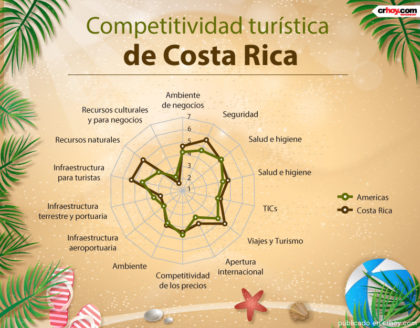
Although Costa Rica continues to be the Central American leader in attracting tourists, it neighbors – Nicaragua and Panama – show a significant growth.
In the last decade, Costa Rica achieved a 54% increase in visitors, while the Panamanians achieved a growth of 85% and Nicaraguans a surprising 158%.
Data from the Central American Integration System (SICA), the Costa Rican Tourism Institute, the Nicaraguan Institute of Tourism and the Tourism Authority of Panama revealed this information.
In 2015, Costa Rica received 2.6 million foreign visitors, 500 thousand more than Panama and 1.2 million more than Nicaragua.
A decade earlier, in 2006, Costa Rica received 1.7 million tourists and surpassed Panama by 907 thousand visitors and Nicaragua by 970 thousand.
The national tourism sector is closely watching the speed of growth of the neighboring countries, but they believe that the Costa Rican advantage is still wide.
They have the base we had in Costa Rica 20 years ago. They are certainly growing. Guatemala and Honduras are also investing in tourism in a very intelligent and orderly manner. Panama is investing too, but in a disorderly way,”
said Pablo Heriberto Abarca, president of the National Chamber of Tourism (CANATUR).
Costa Rica is the most expensive Central American country and the eighth in Latin America, according to the World Economic Forum’s 2015 Travel and Tourism Competitiveness Index.
In the “Price Competitiveness” assessment, Costa Rica is the least attractive: hotels, fuels and purchasing power are poorly valued compared to Panama and Nicaragua. The only item where it receives a better rating is in the cost of the plane ticket.
In international positioning, Costa Rica ranks 42nd among 141 countries in the World Economic Forum’s tourism competitiveness index. Panama ranks 34th and Nicaragua 92nd.
Of the 14 issues analyzed by the WEF, Costa Rica obtains very low ratings on land and port infrastructure.
The best qualifications correspond to security and protection, natural resources, tourist infrastructure and health and hygiene. However, Costa Rica does not approach the maximum score in none of these indicators.
Tourism is an activity of great importance for the country. In 2016, the inflow of foreign currency for tourism amounted to $ 3,043 million (equivalent to 40% of the international monetary reserves of that year).
According to the Central Bank, foreign exchange earnings are six times higher than disbursements, a relation that has been growing over the years.
Tourism is also an engine of the services sector.
According to the State of the Nation, there has been a continuous expansion of tourism since 1998, but with greater force since 2006.
Overall, the activity represented $ 3,657 million in 2016, 6.4% of the Gross Domestic Product.
The main markets of the three countries are different:
The majority of tourists who visit Costa Rica are from North America
The majority of those who opt for Nicaragua are Central Americans
The main market in Panama is South American.